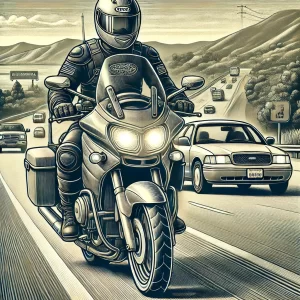- admin
- Personal Injury
- September 23, 2024
Understanding California Motorcycle Laws: A Guide for Riders
Motorcycles offer riders the freedom of the open road, but they also come with unique risks and responsibilities. California has specific laws in place to ensure the safety of motorcycle riders, passengers, and other motorists on the road. Whether you’re a seasoned motorcyclist or a new rider, it’s essential to familiarize yourself with the legal regulations that pertain to motorcycle riding in California.
1. Motorcycle License and Endorsement Requirements
In California, riders must obtain a specific license to operate a motorcycle. There are two types of motorcycle licenses:
- M1 License: This license allows the holder to operate any two-wheeled motorcycle or motorized scooter. Riders must pass both a written and riding skills test.
- M2 License: This license allows riders to operate motorized bicycles and mopeds, but not motorcycles.
For riders under 21 years old, California requires completion of a California Motorcyclist Safety Program (CMSP) course before obtaining a motorcycle license. For riders over 21, the course is optional, but it may waive the riding skills test at the Department of Motor Vehicles (DMV).

2. Helmet Law: Mandatory Use
California’s motorcycle helmet law, enforced under California Vehicle Code Section 27803, mandates that both motorcycle riders and passengers wear a U.S. Department of Transportation (DOT) approved helmet at all times. This law aims to reduce the number of fatalities and severe head injuries in motorcycle accidents. Helmets must fit properly and should not have any visible damage or wear that compromises their effectiveness.
Failure to comply with this law can result in a traffic citation and fines, as well as a possible increase in insurance premiums.
3. Lane Splitting: Legal but Regulated
California is one of the few states that allows lane splitting, which refers to the practice of motorcycles riding between lanes of slow-moving or stopped traffic. The California Highway Patrol (CHP) has issued guidelines for safe lane splitting:
- Riders should avoid lane splitting at speeds greater than 30 mph.
- It’s safer to lane split between the first and second lanes (the far-left lanes) on multilane highways.
- Riders should exercise caution and avoid lane splitting when traffic is flowing at 40 mph or faster.
While lane splitting is legal, reckless or unsafe lane splitting can lead to a traffic citation. Furthermore, in the event of an accident caused by improper lane splitting, liability may fall on the motorcyclist.
4. Passenger Laws
California law requires that motorcycles carrying passengers be equipped with proper footrests for the passenger, as well as a securely attached seat behind the rider. Passengers must also wear a DOT-approved helmet at all times.
Additionally, if a rider is carrying a passenger, they are responsible for ensuring that the passenger understands and follows safe riding practices, such as leaning into turns with the rider.
5. Lighting and Visibility Requirements
To increase motorcycle visibility on the road, California law mandates certain lighting regulations. California Vehicle Code 25650.5 requires motorcycles to have their headlights on at all times, even during the day. This is to ensure that other drivers can see motorcycles, especially in situations with poor visibility.
Additionally, motorcycles must have functioning brake lights, turn signals, and reflectors to improve safety during night riding or inclement weather. Motorcycles built before 1978 are exempt from the daytime headlight requirement.
6. Exhaust and Noise Restrictions
California enforces strict noise restrictions on motorcycles under California Vehicle Code Section 27150. Motorcycles manufactured after 1985 must have exhaust systems that meet the state’s noise standards, which limit the decibel level that motorcycles can produce. The law aims to reduce noise pollution and promote environmental sustainability.
Riders are prohibited from modifying their exhaust systems in a way that amplifies noise beyond what is allowed by law. Violators can face hefty fines and be required to fix their exhaust systems to comply with noise regulations.
7. Insurance and Financial Responsibility
Like all motor vehicles in California, motorcycles must be covered by liability insurance. The minimum insurance requirements for motorcycle riders are:
- $15,000 for injury or death to one person,
- $30,000 for injury or death to more than one person, and
- $5,000 for property damage.
Riders must carry proof of insurance while riding, and failure to provide proof of insurance can result in fines, license suspension, and impoundment of the motorcycle in the event of an accident. In addition to the legal minimum, riders may consider purchasing uninsured/underinsured motorist coverage, collision coverage, and comprehensive coverage for extra protection.
8. Motorcycle Equipment Laws
Motorcycles in California must be equipped with specific safety gear and features to comply with the state’s regulations:
- Mirrors: All motorcycles must have at least one mirror, although two mirrors (one on each side) are recommended for increased visibility.
- Fenders: Motorcycles must have fenders to prevent debris from being thrown up from the tires.
- Muffler: A muffler must be installed to reduce noise emissions and maintain compliance with noise regulations.
Conclusion
Staying compliant with California’s motorcycle laws is crucial for the safety of both the rider and others on the road. From helmet use to lane splitting and insurance requirements, these regulations are designed to protect motorcyclists and ensure that the roads remain safe for everyone. For riders, understanding and following these laws can reduce the risk of accidents, fines, and legal complications while enhancing the overall enjoyment of motorcycle riding in California.
Before hitting the road, motorcyclists should always check for any updates or changes to state laws and ensure their motorcycles meet all legal requirements. Riding responsibly and legally not only promotes safety but also ensures a positive riding experience.

